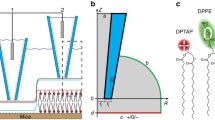Abstract
In this paper, we describe the application of electrochemical impedance spectroscopy (EIS) to characterize process of formation and properties of solid-supported tethered bilayer membranes on solid conducting substrates. Along with the description of experimental procedures to prepare substrates and self-assembly of phospholipid bilayers onto gold-coated glass slides, we describe the detailed protocols of EIS measurements. We demonstrate the utility of EIS in the evaluation of the properties of both molecular anchor layers used to immobilize tBLMs as well as characterization of tBLMs. We show that the EIS methodology extends the applicability of this technique well beyond the mere evaluation of electric parameters. Specifically, we demonstrate how by using EIS one may evaluate both density and size of water-filled defects (ion-channels) in tBLMs, to determine the structural mode (homogeneous, heterogeneous, or clustered) of distribution of defects in tBLMs. Our methodology can be applied in both basic protein membrane interaction studies, as well as in the development of precision biosensoric systems with tBLMs as a sensing element.
Access this chapter
Tax calculation will be finalised at checkout
Purchases are for personal use only
Similar content being viewed by others
References
Veneziano R, Rossi C, Chenal A et al (2017) Synthesis and characterization of tethered lipid assemblies for membrane protein reconstitution (review). Biointerphases 12:04E301. https://doi.org/10.1116/1.4994299
Ragaliauskas T, Plečkaitytė M, Jankunec M et al (2019) Inerolysin and vaginolysin, the cytolysins implicated in vaginal dysbiosis, differently impair molecular integrity of phospholipid membranes. Sci Rep 9:1–11. https://doi.org/10.1038/s41598-019-47043-5
Alvarez-Malmagro J, García-Molina G, López De Lacey A (2020) Electrochemical biosensors based on membrane-bound enzymes in biomimetic configurations. Sensors 20:3393. https://doi.org/10.3390/s20123393
Zhan W, Jiang K, Smith MD et al (2010) Photocurrent generation from porphyrin/fullerene complexes assembled in a tethered lipid bilayer. Langmuir 26:15671–15679. https://doi.org/10.1021/la102884u
Jackman J, Knoll W, Cho N-J (2012) Biotechnology applications of tethered lipid bilayer membranes. Materials (Basel) 5:2637–2657. https://doi.org/10.3390/ma5122637
McGillivray DJ, Valincius G, Vanderah DJ et al (2007) Molecular-scale structural and functional characterization of sparsely tethered bilayer lipid membranes. Biointerphases 2:21–33. https://doi.org/10.1116/1.2709308
Dupuy FG, Pagano I, Andenoro K et al (2018) Selective interaction of Colistin with lipid model membranes. Biophys J 114:919–928. https://doi.org/10.1016/j.bpj.2017.12.027
Su Z, Leitch JJ, Lipkowski J (2018) Electrode-supported biomimetic membranes: an electrochemical and surface science approach for characterizing biological cell membranes. Curr Opin Electrochem 12:60–72. https://doi.org/10.1016/j.coelec.2018.05.020
Budvytyte R, Pleckaityte M, Zvirbliene A et al (2013) Reconstitution of cholesterol-dependent Vaginolysin into tethered phospholipid bilayers: implications for bioanalysis. PLoS One 8:e82536. https://doi.org/10.1371/journal.pone.0082536
Ragaliauskas T, Mickevicius M, Rakovska B et al (2017) Fast formation of low-defect-density tethered bilayers by fusion of multilamellar vesicles. Biochim Biophys Acta Biomembr 1859:669–678. https://doi.org/10.1016/j.bbamem.2017.01.015
Budvytyte R, Mickevicius M, Vanderah DJ et al (2013) Modification of tethered bilayers by phospholipid exchange with vesicles. Langmuir 29:4320–4327. https://doi.org/10.1021/la304613a
Valincius G, Meškauskas T, Ivanauskas F (2012) Electrochemical impedance spectroscopy of tethered bilayer membranes. Langmuir 28:977–990. https://doi.org/10.1021/la204054g
Raila T, Penkauskas T, Jankunec M et al (2019) Electrochemical impedance of randomly distributed defects in tethered phospholipid bilayers: finite element analysis. Electrochim Acta 299:863–874. https://doi.org/10.1016/j.electacta.2018.12.148
Raila T, Ambrulevičius F, Penkauskas T et al (2020) Clusters of protein pores in phospholipid bilayer membranes can be identified and characterized by electrochemical impedance spectroscopy. Electrochim Acta 364:137179. https://doi.org/10.1016/j.electacta.2020.137179
Valincius G, Mickevicius M (2015) Tethered phospholipid bilayer membranes: An Interpretation of the Electrochemical Impedance response, in: A. Iglič (Ed.) Advances in Planar Lipid Bilayers and Liposomes, Elsevier, 2015, pp. 27–61
Valincius G, Mickevicius M, Penkauskas T, Jankunec M (2016) Electrochemical impedance spectroscopy of tethered bilayer membranes: an effect of heterogeneous distribution of defects in membranes. Electrochim Acta 222:904–913. https://doi.org/10.1016/j.electacta.2016.11.056
Author information
Authors and Affiliations
Corresponding author
Editor information
Editors and Affiliations
Rights and permissions
Copyright information
© 2022 The Author(s), under exclusive license to Springer Science+Business Media, LLC, part of Springer Nature
About this protocol
Cite this protocol
Penkauskas, T., Ambrulevičius, F., Valinčius, G. (2022). Electrochemical Impedance Spectroscopy as a Convenient Tool to Characterize Tethered Bilayer Membranes. In: Cranfield, C.G. (eds) Membrane Lipids. Methods in Molecular Biology, vol 2402. Humana, New York, NY. https://doi.org/10.1007/978-1-0716-1843-1_4
Download citation
DOI: https://doi.org/10.1007/978-1-0716-1843-1_4
Published:
Publisher Name: Humana, New York, NY
Print ISBN: 978-1-0716-1842-4
Online ISBN: 978-1-0716-1843-1
eBook Packages: Springer Protocols




